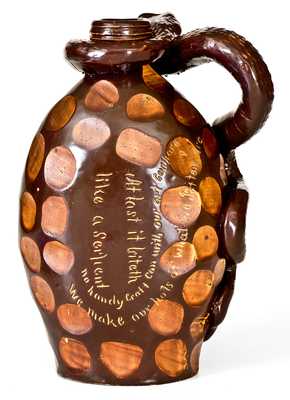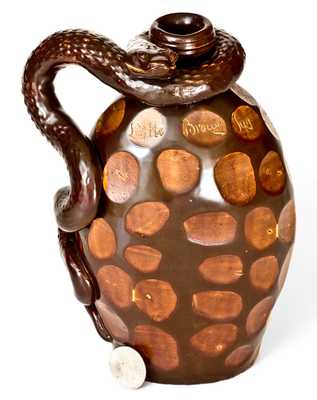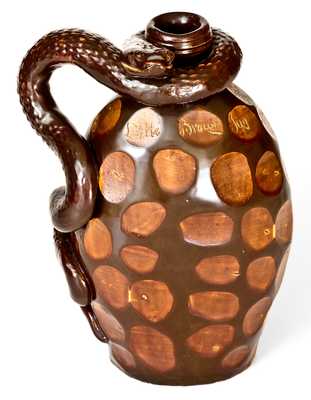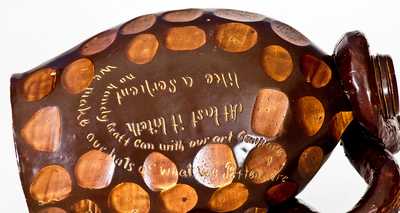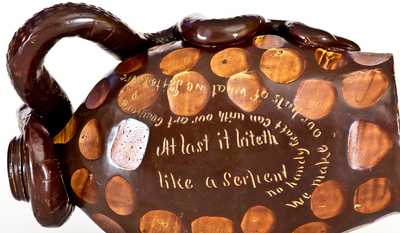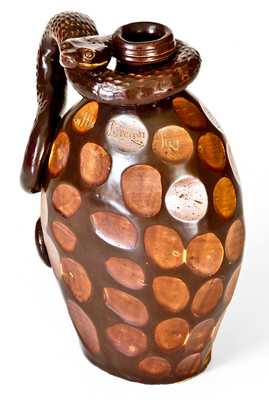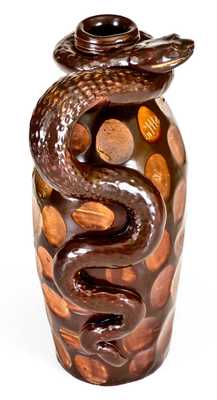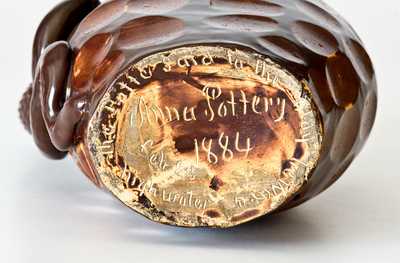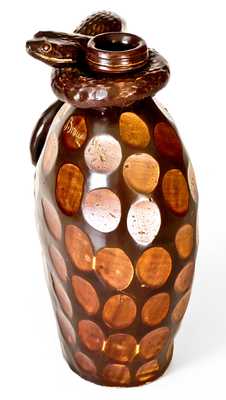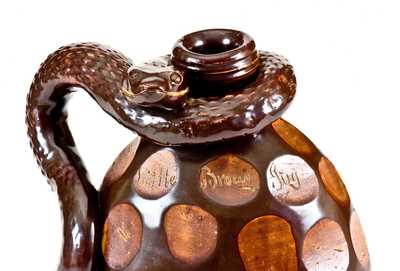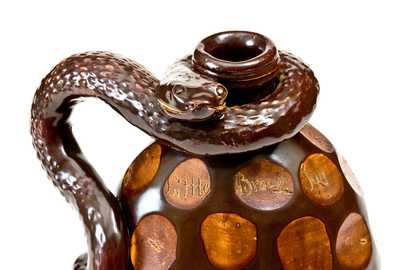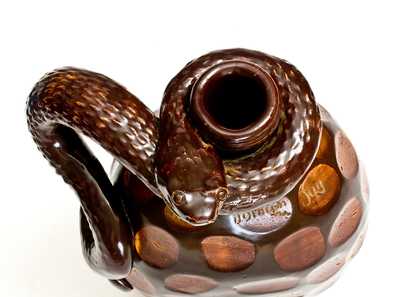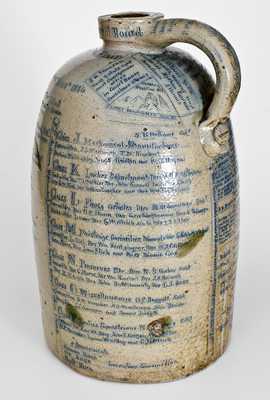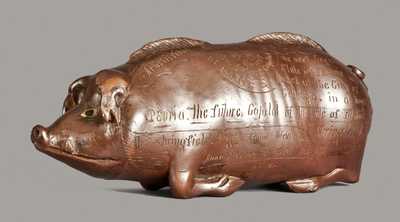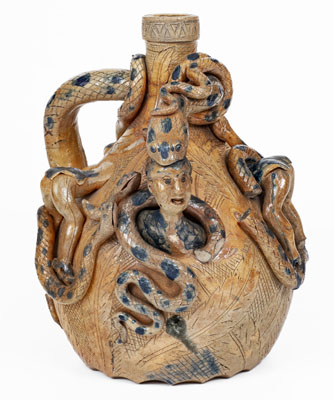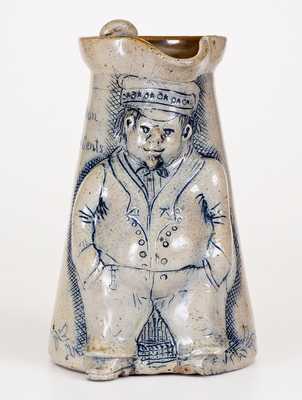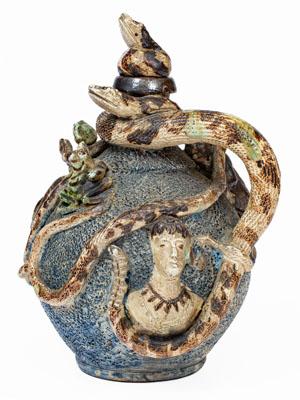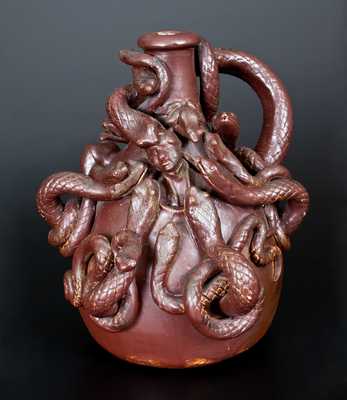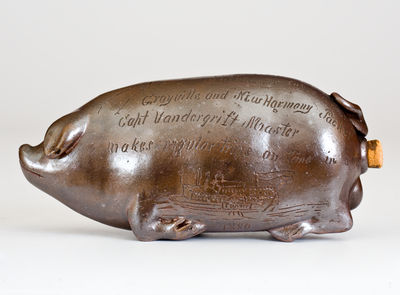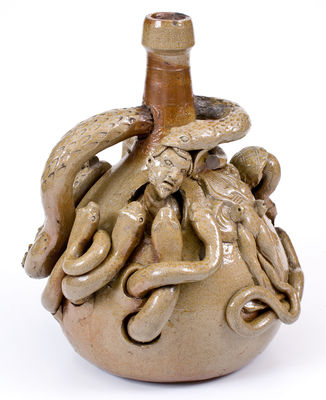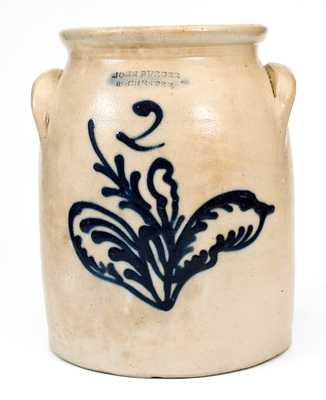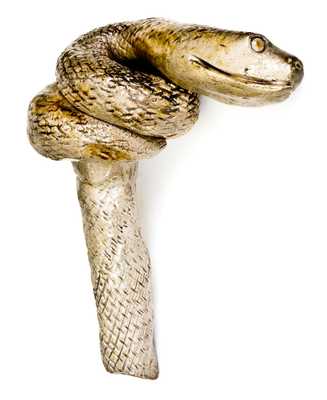Important and Unique Stoneware Snake Flask with Poem and Elaborate Inscriptions, Signed "Anna Pottery, / feb 23 / 1884 / high water", Wallace and Cornwall Kirkpatrick, Anna, IL, 1884, wheel-thrown flask with flattened sides, tooled spout, and handle in the form of a snake constricting the neck and winding down the side of the vessel. Heavy raised scale detail to snake's body, large incised scales to snake's underside, and impressed and incised details to snake's head. Surface covered in a reddish-brown Albany slip glaze and profusely-decorated throughout with chip carving. This textured alteration of the jug's surface appears to be a sort of precursor to treatments which would be seen in the American Art Pottery Movement of future decades, akin to the dimpling found on so many George Ohr pots. The shoulder bears the incised inscription "Little Brown Jug". The reverse is incised with the poetic couplet, "no handy craft can with our art Compare / We make our pots of what we Potters are". A second inscription, incised vertically along a smooth area on the flask's reverse side, reads, "At last it biteth / like a serpent". The underside is incised in a circular fashion around the edge, "the Potter said to the Clay be Ware", forming an arch around the signature "Anna Pottery / 1884 / feb 23 / high water". Few American stoneware objects capture the identity of the potter as this flask does, relating in words and form the role of the potter as both an artist and utilitarian craftsman. The creative powers of the potter are expressed through the play-on-words, "the Potter said to the Clay be Ware," granting him (or her) an almost God-like role in giving form and purpose to something out of nothing (clay). This verse relates to the Biblical story of the creation of the Earth, in which God said, "Let there be light" (Gen. 1:3) and separated the light from the darkness. The renowned Biloxi, Mississippi, potter, George Ohr--influenced by the Kirkpatricks--would go on to likewise tout his importance as artist/creator, using a similar verse on one on his placards, "the potter said un2 the clay 'be, ware' and it was" in the 1890's. The proverb that helps form the centerpiece of the jug, "No handy craft can with our art Compare / We make our pots of what we Potters are," is a version of an old potter's saying that dates back to at least the eighteenth century. (A Staffordshire jug dated 1770, for instance, bears the prominent inscription, "No Art With Potters, Can Compare, we Make our Pots of what we Potters Are.") And this phrase, also rife with Biblical imagery, reveals the ultimate irony of the potter's lot in life: he creates his pottery out of the same substance (earth) from which he was created, and he will return to it when his life is over. Such sentiments of the artist's own mortality have been expressed by potters through the ages. Pennsylvania-German sgraffito potters used similar language on their iconic dishes: One sgraffito verse, mentioned in Barber's 1903 book, Tulip Ware of the Pennsylvania-German Potters, reads, "Die Schisel ist von erd und don / Und die mensch bist auch davon", translating to "This plate is of earth and clay (thon) / And the men are also thereof" (Barber, p. 208). The verse written vertically along the back of the flask, reading "At last it biteth / like a serpent", is taken from Proverbs 23:32 and echoes the vessel's snake-form handle and the Kirkpatricks' fascination with the Temperance Movement. This line is preceded in the Bible with the verse, "Look not thou upon the wine when it is red, when it giveth his colour in the cup, when it moveth itself aright" (Proverbs 23:31). This flask is significant in a number of ways, but none greater than the way in which the Kirkpatricks chose to plainly celebrate their lives as potters and their relationship with the clay and with their industry. It is singular in this respect, and its significance to the Kirkpatricks led them to incise a full date on the underside, "feb 23 1884", followed by the word, "high water," revealing what the weather / environment was like on the day it was made--a treatment and tradition that continues to this day on the underside of pottery. In this case, "high water" refers to the flood waters in towns surrounding the Ohio River during the Great Flood of 1884. Period newspaper accounts bear out that the high water mark of that flood reached certain towns at least about February 23; we know, for instance, that Paducah, Kentucky, saw its high water mark that very day--one that would last at least into the 20th century. This simple, and somewhat cryptic, inscription on the flask has surprisingly become the namesake of this legendary American ceramic object: The Highwater Flask. While the words incised on this flask tell the story of the potter's condition in life, it is the potted form itself that manifests these words in physical form: a true work of art created from a meager natural resource. Literature: Illustrated in Mohr, Pottery, Politics, Art: George Ohr and the Brothers Kirkpatrick, p. 63. Excellent, essentially as-made condition, remarkable given the fragility of the form. H 8".

